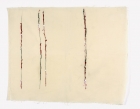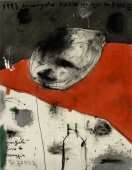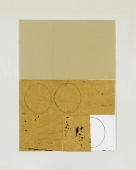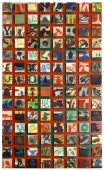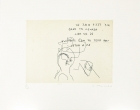
Artist | Robert Gober (*1954)
https://www.artist-info.com/artist/Robert-Gober
 Artist Portfolio Catalog
Artist Portfolio Catalog
| Image | Artist | Title | Year | Material | Measurement | ||||||||||||||||||||
|---|---|---|---|---|---|---|---|---|---|---|---|---|---|---|---|---|---|---|---|---|---|---|---|---|---|
 |
Robert Gober | Ohne Titel | 1994 | ||||||||||||||||||||||

Robert Gober (*1954)Ohne Titel
|
|||||||||||||||||||||||||
 |
Robert Gober | untitled | 1991 | wax, textile, pre-made drainage ... | |||||||||||||||||||||

Robert Gober (*1954)untitled
|
|||||||||||||||||||||||||
 |
Robert Gober | untitled | 1992 | hairy shoe | |||||||||||||||||||||

Robert Gober (*1954)untitled
|
|||||||||||||||||||||||||
Biography
Biography
born in1954
About the work (english / deutsch)
About the work (english / deutsch)
Untitled
Is the Untitled (1991) lower male torso moving into the wall or protruding from it? What has happened to the top half of the body? Does this part of the body, lying on its belly on the floor, refer to an outside or an inside world? Or perhaps we are to understand this corporeal fragment in the same way as Wilhelm Lehmbrucks bronze torso of 1913-14, with its chopped-off head, arms and legs. Of course, Lehmbruck's sculpture did not have pieces chopped off it: the torsos shape, volume, and stance were conceived without the missing parts. To put it differently, in neither substantive nor sculptural terms do the missing parts pin-point or signify an element of absence. (Such finished sculptures, which are based on the remaining fragments of Greco-Roman statues, are inconceivable without the pioneering work of Johann Joachim Winkelmann [1717-68].)
Robert Gober's 1991 lower torso is admittedly a fragment, but it obeys laws unlike those of classical Modernity. Isolated and exposed, it is modeled in wax; complete with body hair it is clad in underpants, socks and shoes. Casts of pre-made drainage points are „screwed“ into the torsos legs and backside, resembling sores the size of saucers. It is down drains that waste water and scumflow into the sewers. And it is the drain in the form of a plughole which a small boy, sitting in a bath tub, is fascinated by: the oscillating, nail-like downward spiral of water. In Gober's piece, memory, decay and exposurel exclusion jell to form a biographical unity.
The drains "screwed into" the lower torso suck memory and death into an imploding body, a body that is collapsing in on itself. Death penetrates the body in the form of a paradox of cleansing (memory) und dirt (disease), and the body thus links decay, exposure and exclusion. The realistic presentation of the lower torso intensives the brutality of such an act of penetration.
However, Untitled does not just address the issue of AIDS. We, as viewers, are by no means excluded. Provoked by Gober, our voyeuristic gaze is conditioned, anthropologically speaking, by a history of pain. We encounter ourselves in the reflection of our own collective obsessions. To use the words of Peter Sloterdijk: "What was held up on high and went almost unchallenged as human productivity for more than two centuries is increasingly revealing its destructive und addictive character." ("Im selben Boot - Versuch über die Hyperpolitik", [In the same Boat - An Essay on Hyperpolitics], FrankfurtIMain, 1993, p. 79).
German text by Jean-Christophe Ammann / Translation by Jeremy Gaines
(Extract - Full printed version available in the Museum)
MMK - Museum für Moderne Kunst, Frankfurt am Main
Ohne Titel
Führt der männliche Unterleib - Ohne Titel, 1991 in die Wand hinein oder ragt er aus der Wand heraus? Wo befindet sich der Oberkörper? Deutet dieser bäuchlings auf dem Boden liegende Körperteil den Außen- oder den Innenraum an? Oder ist vielleicht dieses Körperfragment so zu verstehen wie etwa ein 1913/14 entstandener Bronzetorso von Wilhelm Lehmbruck mit abgeschlagenem Kopf, Armen und Beinen? Natürlich sind die Glieder der Lehmbruckschen Skulptur nicht abgeschlagen: Gestalt, Volumen und Haltung wurden ohne die fehlenden Teile konzipiert. Oder anders ausgedruckt: Die fehlenden Glieder bezeichnen und bedeuten weder inhaltlich noch skulptural ein Moment der Abwesenheit. (Ohne die bahnbrechende Vermittlung von Johann Joachim Winckelmann (1717-1768) sind solche vollendeten, auf griechisch-römischen Figurenfragmenten beruhende Skulpturen kaum denkbar.)
Robert Gobers Unterleib (1991) ist zwar Fragment, aber er gehorcht anderen Gesetzen als jenen der klassischen Moderne. Er ist, isoliert und ausgesetzt, in Wachs modelliert, behaart, mit Unterhose, Socken und Schuhen bekleidet. Abgüsse von vorgefertigten Abflußlöchern sind in Beine und Gesäß "hineingeschraubt", als handle es ich um handtellergroße Schwären. Abflußlöcher sind der Ort, wo das schmutzige Wasser, der Abschaum, in die Kloake fließt. Abflußlöcher sind aber auch der Ort, wo der kleine Junge, in der Badewanne sitzend, fasziniert der oszillierenden, nagelförmigen Wasserspirale zuschaut. Erinnerung, Aussatz, Ausgesetztsein verbinden sich in diesem Werk zu einer biographischen Einheit.
Die in den Unterleib "geschraubten" Abflußlöcher saugen Erinnerung und Tod in einen implodierenden, in sich selbst zusammenstürzenden Körper. Der Tod dringt im Paradox von Reinheit (Erinnerung) und Schmutz (Krankheit) in den Körper ein, der, vorgezeichnet, Aussatz und Ausgesetztsein verbindet. Die realistische Darstellung des Unterleibes verstärkt die Brutalität des Eingriffs.
Jedoch ist nicht allein Aids angesprochen. Wir, als Betrachter, stehen keineswegs außerhalb. Unser voyeuristischer Blick, den Gober provoziert, ist anthropologisch durch die Leidensgeschichte konditioniert. Wir begegnen uns im Spiegel unserer eigenen kollektiven Obsessionen. Sagen wir es mal mit den Worten von Peter Sloterdijk: "Was mehr als zweihundert Jahre lang fast unangefochten als menschliche Produktivität gefeiert wurde, wird zunehmend in einem destruktiven und suchthaften Charakter durchschaubar" ("Im selben Boot - Versuch über die Hyperpolitik", Frankfurt/M. 1993, s. 79).
Text von Jean-Christophe Ammann / Translation by Jeremy Gaines
(Auszug - Der vollständige Text ist als Informationsblatt beim Museum erhältlich)
MMK - Museum für Moderne Kunst, Frankfurt am Main
 Exhibition Announcements Exhibition Announcements 
| Learn more about this service |
|---|
 offers / Requests offers / Requests  |
Learn more about this service |
|---|
 Visualization |
Learn more about this service | ||
|---|---|---|---|

Interested in discovering more of this artist's networks?
3 easy steps: Register, buy a package for a visualization, select the artist.
See examples how visualization looks like for an artist, a curator, or an exhibition place: Gallery, museum, non-profit place, or collector.

Exhibition History

|
SUMMARY based on artist-info records. More details and Visualizing Art Networks on demand. Venue types: Gallery / Museum / Non-Profit / Collector |
||||||||||||
| Exhibitions in artist-info | 164 (S 28/ G 136) |
Did show together with - Top 5 of 1686 artists (no. of shows) - all shows - Top 100
|
||||||||||
| Exhibitions by type | 164: 65 / 60 / 37 / 2 | |||||||||||
| Venues by type | 112: 41 / 36 / 33 / 2 | |||||||||||
| Curators | 85 | |||||||||||
| artist-info records | May 1984 - Sep 2016 | |||||||||||
|
Countries - Top 5 of 12 United States (86) Germany (31) Switzerland (10) Belgium (6) France (5) |
Cities - Top 5 of 56 New York (62) Frankfurt am Main (9) Köln (5) Boston (4) Basel (4) |
Venues (no. of shows )
Top 5 of 112
|
||||||||||
Curators (no. of shows)
Top 5 of 85
|
| The Met Breuer | G | Mar 2016 - Sep 2016 | New York | (7) | +0 | |
| Luxembourg & Dayan - New York | G | Feb 2016 - Apr 2016 | New York | (24) | +0 | |
| Whitney Museum of American Art | G | Nov 2015 - Mar 2016 | New York | (365) | +0 | |
| Sussman, Elisabeth (Curator) | +0 | |||||
| Gilman, Sondra (Curator) | +0 | |||||
| Macel, Christine (Curator) | +0 | |||||
| Sherman, Elisabeth (Curator) | +0 | |||||
| Fondazione Nicola Trussardi | G | Aug 2015 - Nov 2015 | Milano | (21) | +0 | |
| Gioni, Massimiliano (Curator) | +0 | |||||
| Whitney Museum of American Art - America Is Hard to See | S | May 2015 - Sep 2015 | New York | (1) | +0 | |
| De Salvo, Donna (Curator) | +0 | |||||
| Foster, Carter E. (Curator) | +0 | |||||
| Miller, Dana (Curator) | +0 | |||||
| Rothkopf, Scott (Curator) | +0 | |||||
| Saatchi Gallery | G | Nov 2014 - Mar 2015 | London | (20) | +0 | |
| Erofeev, Andrey (Curator) | +0 | |||||
| Livingstone, MArco (Curator) | +0 | |||||
| CHANG, Tsong-zung Johnson (Curator) | +0 | |||||













